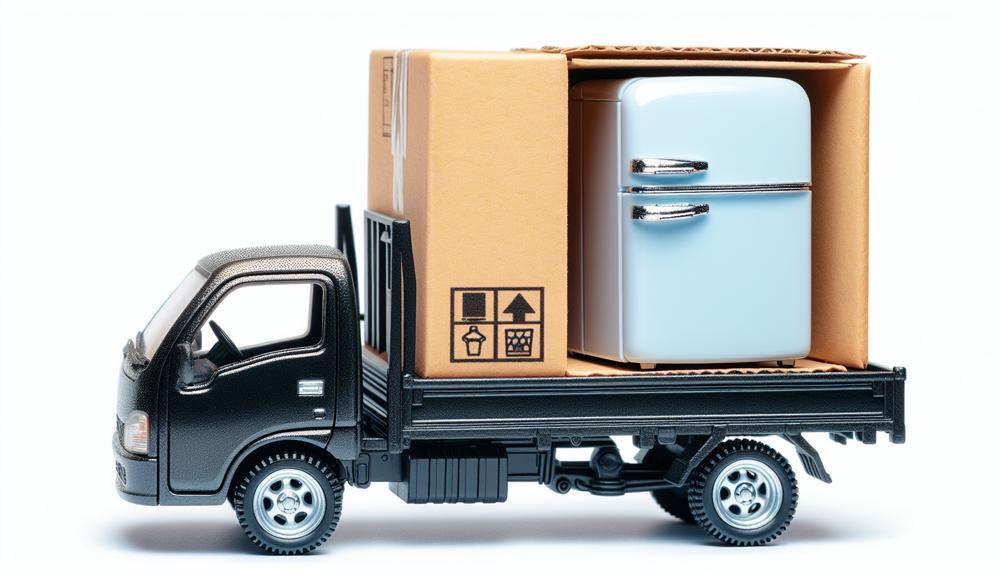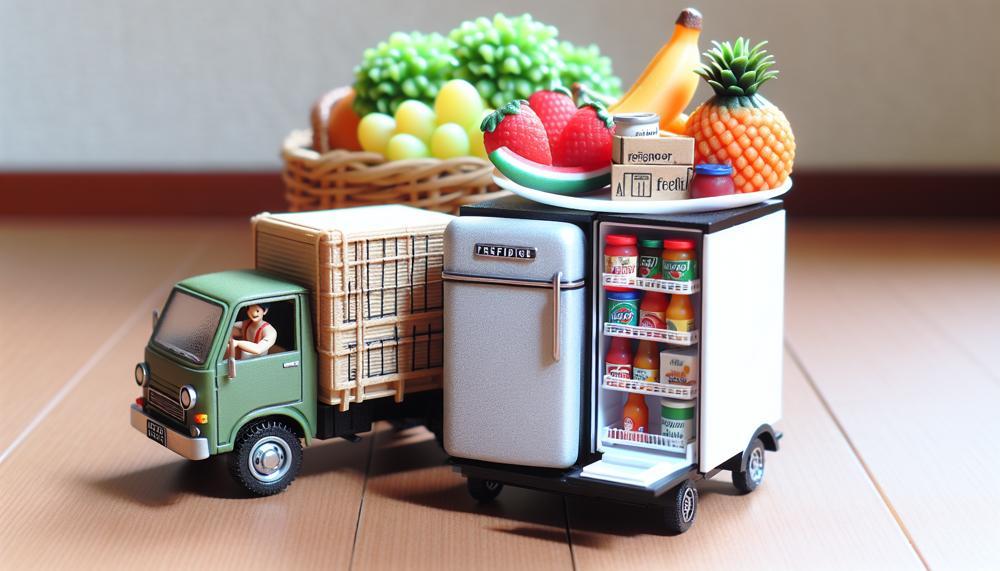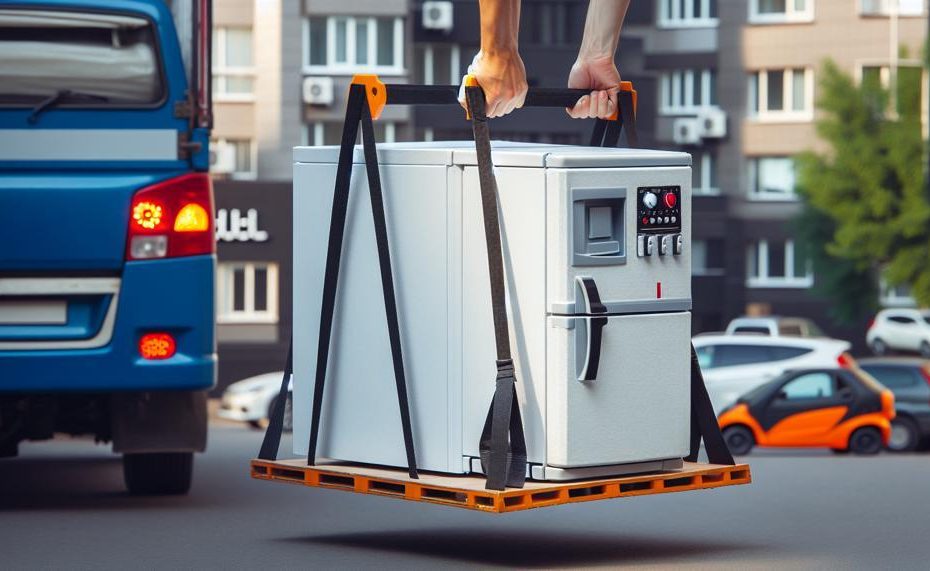You’ve finally found the perfect mini fridge to complete your dorm room or apartment setup. It’s sleek, compact, and has just enough space for all your favorite snacks and drinks. But before you can start enjoying its cooling powers, you have to figure out how to get it home.
And that’s when the questions arise: Can a mini fridge be transported on its side? Is it safe? Will it damage the fridge?
In this blog post, we’ll tackle these burning questions and provide you with all the necessary information for safely transporting a mini fridge on its side.
From understanding why it’s not recommended to learning how to properly prepare and secure your fridge, we’ve got you covered.
Here’s what we’ll cover in detail:
- The dos and don’ts of transporting a mini fridge on its side
- The potential consequences of disregarding this recommendation
- Expert tips for securing your mini fridge for transportation
- Alternative methods for moving a mini fridge if laying it on its side is not an option
So, whether you’re moving into a new place or simply need to transport your mini fridge from one location to another, keep reading for everything you need to know about safely transporting it on its side.
Don’t let any bumps in the road ruin your perfectly chilled snacks – follow our guide and ensure a smooth journey for your mini fridge.
Contents
- 1 What Happens When You Transport a Mini Fridge on Its Side?
- 2 What To Do After Transporting a Mini Fridge on Its Side
- 3 My Refrigerator Was Transported on the Side. Can I Turn It On?
- 4 How Long Can a Refrigerator Lie on Its Back?
- 5 Can You Transport a Freezer on Its Side?
- 6 How Do You Fix A Refrigerator That Was Laying Down?
- 7 Below Is Data on Some of the Most Highly Recommended Ways of Moving a Mini-Fridge:
- 8 Tips of Moving a Mini Fridge
- 9 Related Posts
- 10 Conclusion
What Happens When You Transport a Mini Fridge on Its Side?
Transporting a mini fridge on its side can result in negative consequences, including coolant leaks, inadequate cooling, and a shortened lifespan for the appliance. To avoid these consequences, it is important to follow these simple steps:
- Transport the fridge in an upright position: It is highly recommended to transport mini fridges in a standing position to minimize the risk of coolant leakage and prevent internal damage.
- Allow for proper resting time: In situations where laying the fridge on its side during transport is unavoidable, ensure that it is allowed to rest in an upright position for the same amount of time that it was horizontal (e.g. 4 hours of horizontal transport should be followed by 4 hours of vertical resting). This will allow the fluids inside to settle back into their designated places and prevent any issues with the compressor.
- Check for any displaced parts: Before turning on the fridge, thoroughly inspect for any dislodged or misaligned parts. If any issues are noticed, it is best to seek guidance from an expert before attempting to use the appliance.
- Tilt instead of lay: In situations where tilting the fridge during transport is necessary, ensure that one side of the base is securely supported to prevent oil spillage and minimize disturbance to the sealed system.
- Seek expert advice: If there is uncertainty about how to properly transport your specific fridge model or if there are any concerns, it is always advisable to consult with the brand’s representative or an expert for guidance.
What To Do After Transporting a Mini Fridge on Its Side
To guarantee the proper functioning and safety of your mini fridge after transporting it on its side, follow these instructions:
Allow it to rest upright for at least 4-6 hours
After transporting your mini fridge on its side, it is crucial to let it settle upright for 4-6 hours before plugging it in. This allows the compressor oil to return to its correct position and avoid potential damage.
Check the temperature settings
Once the fridge has been upright for a few hours, adjust the temperature settings. It is recommended to set the temperature slightly lower than usual for the first 24 hours to allow the fridge to stabilize.
Inspect the door seals
Transporting a fridge on its side can loosen or misalign door seals. Ensure all seals are correctly aligned and tightly sealed for maximum efficiency.
Clean the interior of the fridge
Before storing any food items inside, thoroughly clean the interior of the fridge. Dust and debris may have accumulated during transportation, affecting the cooling system and contaminating food.
Conduct a test cycle
After completing these steps, run a test cycle on the fridge to identify any potential issues or malfunctions. If any concerns arise, contact a professional for assistance.
Remember, following these steps after transporting a mini fridge on its side can prevent damage and ensure proper functioning for years to come.
My Refrigerator Was Transported on the Side. Can I Turn It On?
Transporting a refrigerator on its side is not advisable as it can harm the appliance’s internal mechanisms. However, if you have no choice but to do so, there are precautions you can take to ensure safe operation afterwards.
These include properly preparing the fridge for transport, gently tilting it onto its side, and allowing it to stand upright for a minimum of 24 hours before powering it on.
If you experience any problems after turning on the refrigerator, it is best to seek professional help.
How Long Can a Refrigerator Lie on Its Back?
While it is safe to transport a compact refrigerator on its side, it is not recommended to keep it in that position for an extended period of time. Ideally, a mini fridge should be transported in an upright position, but if this is not feasible, it can be transported on its side for a short period of time with proper precautions.
A compact refrigerator should not be kept on its side for more than 24 hours. This is because the internal components of the fridge, such as the compressor and shelves, are designed to operate in an upright position. Keeping the fridge on its side for too long can cause damage or malfunction.
To safely transport a mini fridge on its side, it is important to prepare it beforehand. This includes fully emptying the fridge and unplugging it from the power source. It is also recommended to secure the fridge with straps or tie-downs and cover it with something soft, such as a blanket or towel, to prevent tipping or damage.
Upon arrival at your destination, it is crucial to promptly place the mini fridge back in an upright position. This will allow the fluids inside the fridge to return to their original location and prevent potential issues with the compressor.
Additionally, if you are transporting the mini fridge on top of carpeted flooring, it is important to note that this can impede ventilation and cause overheating. It is best to place the fridge on a hard surface such as linoleum or vinyl flooring.
Can You Transport a Freezer on Its Side?
It is not advisable to transport a compact refrigerator on its side as it can cause harm to the compressor and internal components. However, in cases where it cannot be avoided, there are certain measures that can be taken to minimize potential damage.
When transporting a compact refrigerator on its side, it is crucial to adhere to the following steps to ensure the safety and functionality of your appliance:

- Keep it upright for at least 24 hours: After moving a compact refrigerator on its side, it is important to keep it upright for at least 24 hours before using it again. This gives the refrigerant oil time to settle back into the compressor, preventing any potential issues with cooling.
- Read the manual: Different brands may have specific instructions for transporting their compact refrigerators. Be sure to read the manual beforehand and follow any guidelines or precautions mentioned.
- Clean and defrost properly: Prior to moving your compact refrigerator, ensure that it is properly cleaned and defrosted. This will prevent any water leakage during transportation. Additionally, secure any loose items inside the fridge to prevent them from shifting and causing damage.
- Use a dolly: If possible, use a dolly or hand truck when moving the compact refrigerator. This will reduce the risk of dropping or damaging the appliance during transportation.
- Strap it tightly: When transporting in a vehicle, carefully measure and lay the fridge on its side where the compressor is located. Use straps or bungee cords to securely fasten it and prevent shifting during transportation.
- Get assistance: It is not recommended to move a compact refrigerator by yourself as it can be heavy and difficult to maneuver. Make sure to have help available and all necessary equipment before attempting to move it.
- Contact repair center: If you notice any issues with your compact refrigerator after transportation, such as cooling problems or unusual noises, contact the brand’s repair center for assistance.
In conclusion, while it is not ideal to transport a compact refrigerator on its side, if it is necessary, it is essential to take proper precautions and follow the manufacturer’s instructions.
How Do You Fix A Refrigerator That Was Laying Down?
Transporting a refrigerator while laying it on its side can result in damage to the compressor and cooling system, potentially leading to cooling problems. If you have recently moved your refrigerator and it was transported on its side, there are steps you can take to fix it:
- Empty the contents and store food safely: Before attempting any repairs, it is crucial to remove all items from your refrigerator. Place any perishable items in a picnic cooler with ice to prevent them from spoiling while you work on the fridge.
- Take out shelves, racks, and drawers: To make the refrigerator easier to handle, remove any shelves, racks, and drawers that can be safely detached. For those that cannot be removed, secure them with tape to avoid shifting during transportation.
- Defrost the freezer: If your freezer was not defrosted before transportation, make sure to defrost it now. This will prevent excess water buildup in the fridge.
- Seal the door tightly: Before moving the fridge again, ensure that the door is securely sealed. This will prevent outside air from entering and causing temperature fluctuations inside.
- Inspect doors and entrances: Check for any damage to your doors or entrances that may have occurred during transportation. If there are dents or misaligned doors, it may be necessary to contact a repair center for assistance.
- Allow proper time standing upright: It is recommended to let your refrigerator stand upright for at least the same amount of time as it was on its side before plugging it in. If it was on its side for more than 24 hours, let it stand upright for 24 hours before turning it on.

By following these steps, you can ensure that your refrigerator is ready to use again and avoid potential cooling problems caused by transportation while laying on its side.
Below Is Data on Some of the Most Highly Recommended Ways of Moving a Mini-Fridge:
When it comes to moving a mini fridge on its side, there are some precautions that must be taken to ensure its safety and avoid any potential damage. Here, we will cover the most highly recommended methods for transporting a mini fridge on its side:
Prepare the fridge for transport
Before attempting to lay the fridge on its side, it’s crucial to defrost and clean it thoroughly. This will prevent any spills from occurring during the journey.
Disconnect the fridge correctly
It’s important to follow the manufacturer’s instructions for disconnecting your specific model of fridge. This will prevent any harm to the internal components.
Remove all loose items
Make sure to take out all shelves, drawers, and other loose items from inside the fridge. These could shift during transport and cause damage.
Protect the interior and exterior of the fridge
To prevent any bumps or scratches during transport, use blankets or towels to wrap around the fridge.
Secure the fridge with a rope or strap
Using a sturdy rope or strap, secure the fridge in place to prevent it from shifting during transport.
Drive carefully and choose smooth routes
Avoid rough roads and drive cautiously, taking turns slowly to avoid any potential damage to the fridge.
Let it rest before turning it back on
Once you reach your destination, allow the fridge to rest in an upright position for at least 4 hours (up to 24 hours) before turning it back on. This will allow any oil that may have shifted during transport to settle back into place.
By following these highly recommended methods, you can safely transport a mini fridge on its side without causing any significant issues.
Tips of Moving a Mini Fridge
Before moving your mini fridge, ensure that it is completely emptied of all its contents. Besides making it easier to move, this will also prevent any items from shifting or breaking during transportation.
Unplug the appliance
It is essential to unplug your mini fridge from its power source before moving it. This will eliminate the risk of electric shocks and potential damage to the fridge.
Use a dolly or flat surface
Moving a mini fridge can be tricky due to its weight and size. To make the process smoother, utilize a dolly or another flat surface to transport the fridge. This will also keep it upright during transportation.
Secure the doors with bungee cords
To avoid any accidents, wrap two or more all-purpose bungee cords around the fridge like belts to keep the doors closed during transit.
Drive cautiously
When transporting a mini fridge, drive carefully and avoid any sudden stops or sharp turns. This will prevent the fridge from shifting and getting damaged.
Choose smoother roads
Opt for smoother routes while transporting your mini fridge. Rough or bumpy roads can cause harm to the appliance and affect its performance.
Let it rest upright before turning it on
If you need to lay your mini fridge on its side during transportation, allow it to rest upright for at least 4 hours (up to 24 hours) before turning it on. This will enable the oil in the compressor to settle back in place, preventing any potential cooling issues in the future.
Related Posts
When it comes to moving your mini fridge on its side, there are several important factors to keep in mind to ensure the safety of your appliance. These include the design of the fridge, precautions to take, and potential risks. In this section, we will delve into these factors and provide helpful tips for successfully transporting your mini fridge on its side.
Fridge Design:
The first factor to consider is the design of your mini fridge. Some models are specifically designed to be transported on their side, while others may be more prone to damage when moved this way. Before attempting to transport your mini fridge on its side, be sure to check the manufacturer’s guidelines or consult with an expert for guidance.
Precautions to Take:
To safely transport your mini fridge on its side, there are several precautions you should take. First, be sure to empty out the contents of the fridge to avoid any spills or damages.
Next, secure the doors with bungee cords or straps to prevent them from opening during transit. You should also wrap the fridge in protective material and secure it with straps or bungee cords to avoid any damage.
Risks:
Transporting a mini fridge on its side can come with some risks. If not properly secured, the fridge may fall over during transit, resulting in damage or injury. Additionally, vibrations from movement can cause shelves or other internal components to become loose and potentially break.
In hotter environments, there is also a risk of the compressor overheating if the fridge is left on its side for too long.
Tips for Safe Transport:
To avoid any potential damage or risks when moving your mini fridge on its side, here are some helpful tips:
- Use a sturdy box or container: This will provide an extra layer of protection for your appliance during transport.
- Pad the inside of the container: Use blankets or padding to cushion the fridge and prevent any bumps or movements.
- Secure with straps or bungee cords: This will keep the fridge in place and prevent it from falling over or shifting during transit.
- Avoid sudden movements or bumps: Try to transport the fridge on flat, smooth roads to minimize any jolts or vibrations.
So, transporting a mini fridge on its side can be a safe and beneficial process if done correctly. By considering the design of your fridge, taking necessary precautions, and following our tips, you can successfully move your mini fridge without causing any damage.
Conclusion
In conclusion, while it may seem convenient to transport a mini fridge on its side, it is not recommended due to potential consequences. This includes coolant leaks, inadequate cooling, and a shortened lifespan for the appliance.
However, if you must transport your mini fridge horizontally, proper preparation and securing of the appliance is crucial.
Additionally, allow for sufficient resting time before plugging it in and consider seeking expert advice if needed.
Once your mini fridge has been safely transported, make sure to follow our tips for ensuring its safe operation. Remember, taking these precautions can prevent any bumps in the road from ruining your perfectly chilled snacks.
So, keep our guide in mind next time you need to move your mini fridge – trust us, your snacks will thank you.





